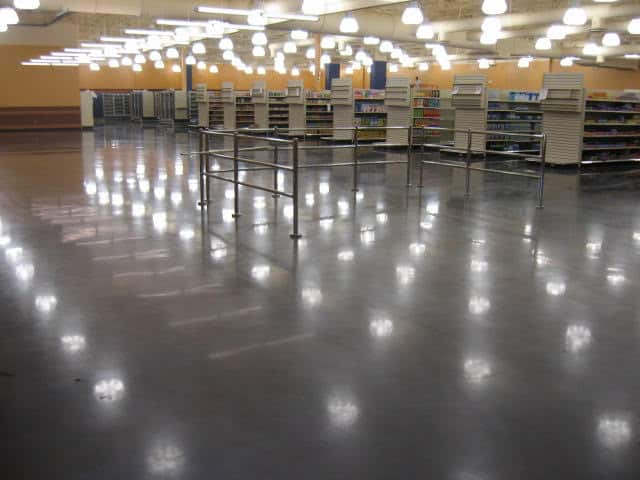What are Polished Concrete Floors
Polished concrete floors are a popular and eco-friendly choice for commercial settings as well as for homeowners. Not only do they look amazing, but they’re also highly durable and extremely low maintenance. In fact, polished concrete has a lower total ownership cost due because it doesn’t easily wear down and requires little upkeep when compared to other flooring materials like tile floors or epoxy flooring.
If you’re considering polished concrete flooring as a flooring option for your office or warehouse building – or even for your home, you may be wondering if concrete floors are cold. Will having polished concrete affect overall heating and cooling costs? Is it comfortable on bare feet? Let’s take a look…

Highly Reflective Polished Concrete
Are Polished Concrete Floors Cold?
Yes, but really no more so than most other hard flooring material like natural stone or ceramic tile.
This part gets a bit more technical.
The heat resistance of insulating materials is inversely related to the thermal conductivity of heating materials. So the easier that a material conducts heat, the less effective it will be as an insulator. For your home or office building, you want
According to a study published in an NIH journal, the following are major considerations when it comes to determining how well polished concrete will work as an insulator:
- Age of the concrete slab
- Aggregates used in the polished floor
- Moisture content of the existing concrete floor
- Density of the concrete surface
While a concrete contractor can adjust some of these variables as part of concrete pour and subsequent concrete grinding and polishing process – it is difficult to significantly improve the insulating properties of a sealed concrete floor.
Making Your Polished Concrete Floor Warmer
There are three main methods to warm up your concrete floor:
- Radiant Heating
- Insulation
- Floor Coverings
Radiant Floor Heating
One way to keep concrete floors warm is to install radiant underfloor heating into the subfloor. This system uses electrical resistance to transfer heat directly to the surface of the floor.
Radiant heating must be installed along with a new concrete floor – it isn’t something that can be easily added to an existing concrete floor.
Insulation
It is important that your concrete floor is properly insulated to avoid the thermal conductivity properties of concrete. Proper insulation will prevent your concrete floor from transferring heat into the underlying ground our outside air.
Floor Coverings
A floor covering can be used to mitigate heat loss due to concrete‘s thermal conductivity. Homeowners may wish to place a carpet pad and carpet on top of a polished concrete floor in order to minimize heat loss.
Putting down an area rug or two may be an even better solution as you’re not hiding the inherent beauty of your polished concrete. While the effect on heat loss would be minimal, it may create a more comfortable environment for walking around.
Making Your Concrete Floors Appear Warmer
We’ve established that concrete polishing results in a floor that has insulating properties no worse than any other hard surface flooring solution.
To many people, the smooth, glossy, elegant-looking grey surfaces just look cold.
The good news is that you can have a decorative concrete floor to be just about any color, pattern, or design that you can imagine. That way, you can make your polished concrete floor appear to be much warmer and more inviting.
The two major ways to take the appearance of your concrete floor to the next level are with Acid Stained Concrete or using a concrete dye.
Acid Stain Concrete
Acid Stained Concrete is the process of adding color to concrete through the use of a chemical acid stain. The acid reacts with the minerals in the concrete to create unique, one-of-a-kind colors. Acid staining is permanent and will not fade or chip like paint or other coatings. It is also low maintenance and easy to clean.
Acid Stained concrete can provide you with a much warmer-looking concrete floor that comes in a variety of earth tones – most notably brown, green, or blue. The result is a beautiful and stylish floor with a lot of character.
Concrete Dye
Using concrete dye creates a concrete floor that matches your specifications completely. There are many colors to choose from when dyeing concrete, so you can create the perfect look for your home or business.
Dyed concrete is extremely durable – although not quite as permanent as stained concrete. You’ll want to make sure that you apply a UV Sealer to protect your dyed concrete floors.

Concrete Dye Used to Make a School’s Concrete Floor Stand Out
Additional Design Options
Your concrete floor can also incorporate logos, or different patterns and designs through the use of stencils. The stencils give you complete flexibility for your floor and are quite the departure from the glossy grey color.